How far to plant eggplants?

It is customary to grow eggplants in seedlings. This option is used in many regions of Russia. The seed is sown in containers, the seedlings are looked after, and the finished seedlings are transferred to open ground or greenhouses.
To achieve high yields, you need to choose the right scheme for growing a fruit crop. If the planting is too thickened, the seedlings will not develop properly and will not be able to produce a rich harvest.

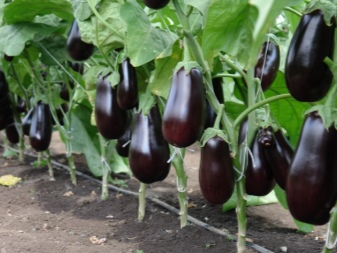
Greenhouse schemes
The method of planting eggplant in greenhouses is almost the same as planting seedlings in the open air. The difference between these methods lies in the timing of the transfer of the plant from containers to the site. Due to the fact that the bushes in the greenhouse are better protected from unfavorable weather conditions, the seedlings can be transferred there 14-28 days earlier than the terms provided for open ground. The date of plant transplantation is adjusted taking into account their condition.
Gardeners have developed several schemes for planting vegetables, differing in density and other characteristics. The first option is called single row. Low-growing eggplants should be planted at a distance of 40 cm.
The gap for medium-sized shrubs is increased to 50 centimeters, for tall ones - up to about 60 centimeters. Shrubs should be comfortable in the garden, taking into account their growth and the structure of the leaf plates.
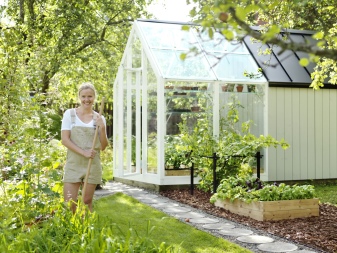
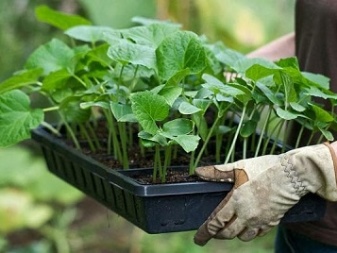
When making a landing in two rows, a gap of 50–70 centimeters is left between them. In this case, it is recommended to place the plants in a checkerboard pattern. At this distance, the shrubs will not cast a shadow over each other, and the roots will receive enough free space for full development. When choosing a scheme, be sure to consider the size of the plants. Some varieties form compact shrubs, others are spreading, with a dense and lush green mass. Growth rate also influences the choice of planting pattern and optimal spacing between bushes and rows.
If a drip irrigation system is installed on the site, its presence must also be taken into account. Seedlings should be planted in such a way that they receive a sufficient amount of water. Such an irrigation system will be useful when growing moisture-loving crops. When planting vegetable seedlings, you need to take into account the following features.
- When planting eggplant in narrow and compact rows, it is sufficient to use only one irrigation belt. It is placed between the rows next to the seedlings or as close to their stems as possible.
- At medium sizes, two tapes will be needed to ensure sufficient irrigation of the plants. So the vegetables will receive all-round hydration. Regular to moderate watering is important to form juicy and tasty vegetables.
- Three irrigation belts are needed in case of spacious beds. The main thing is that the shrubs get enough water, especially during the hot season.
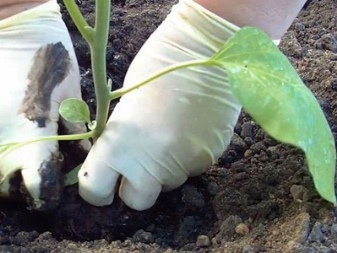
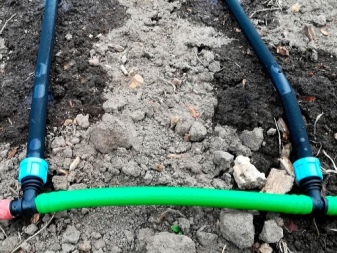
Open ground methods
It is necessary to plant seedlings in open areas only when the weather conditions are appropriate. The soil should warm up to about 18 degrees Celsius, and the early spring frosts should completely recede. If frosts return, young and immature plants can be severely damaged or killed. Before planting, a hardening procedure must be carried out. Boxes with seedlings are taken out into fresh air and left for a certain time so that they adapt to new conditions.Every day, the time period is gradually increased. First, the seedlings are left for an hour, gradually increasing the time to a day. If you skip this step, it will be difficult for shrubs to get used to new weather conditions, and the adaptation process can be very delayed.
Before planting, the eggplant bed is watered abundantly. It is necessary to take plants out of containers carefully so as not to damage the soft and thin roots. After that, each seedling is placed in a planting pit. They need to be prepared in advance. In most cases, a portion of fertilizers or a special soil mixture mixed with organic matter and minerals is placed in the holes. Experienced summer residents say that it is not necessary to deeply deepen the shrubs during the planting process, otherwise they will feel discomfort, which will negatively affect the growth, development and fruiting of the culture. The transfer of the plant is performed in the evening, at sunset.
If plants from the Solanaceae family used to grow in the selected area, it is better to choose another place for growing eggplant. These crops draw a large amount of nutrients from the soil, so the soil needs to rebalance them. The process takes approximately two years. Locations where legumes, cucumbers or cabbage were previously grown are great. After these plants, the soil retains a large amount of nutrients that eggplants will need in the process of growth and fruiting.
You can place seedlings in any way, it all depends on the configuration of the garden and the characteristics of the variety (growth rate, height, structure of the root system and other characteristics).
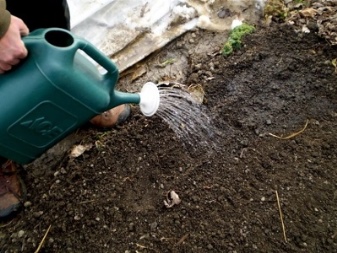
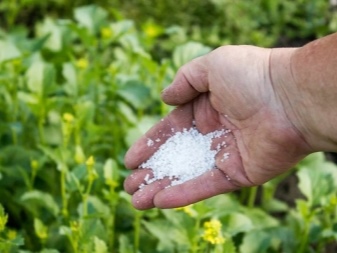
In rows
One of the most common ways to decorate a site is to plant in rows. Also, this option is often called tape or one-sided. Depending on the size of the plantation, the planting can be two or three lines. In any case, you need to adhere to certain rules. When choosing a suitable method, it is imperative to take into account the size of the location and the variety of eggplant.
Today, the following planting pattern is widespread and can be used for most varieties: the minimum distance between the rows should be at least 70 centimeters, and it is highly discouraged to reduce this figure. The space between bushes can vary. In one row, it can count from 30 to 40 centimeters, no less and no more. The landing should be fairly spacious. If you follow this simple rule, you can not worry about the comfort of the vegetable crop.
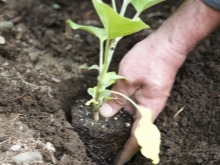
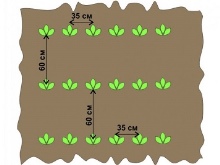
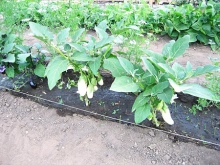
Square-nested
The following method is widely used due to its convenience and practicality. Plants planted in this way do not cast a shadow on each other and coexist wonderfully in the garden. Square-nested planting will have a positive effect on yield, but much depends on the characteristics of the variety, or rather, the height of the bushes.
Experienced gardeners are advised to adhere to important recommendations.
- All tall shrubs are impressive in size. To make them comfortable, the seedlings are planted according to the scheme of 70x70 or 60x60 centimeters. If the location allocated for growing is spacious, you can safely choose the first option.
- A seating arrangement of 40x40 or 50x50 centimeters is great for undersized peppers. Due to its more compact size, it can be placed closer to each other.
- For the last category, which includes medium-sized plants, choose one of the above schemes. Some gardeners calculate the average value, considering it to be optimal. In order not to harm the plants, it is advisable to opt for a more spacious scheme. Keep in mind that free space is needed not only for the aboveground part of the plants, but also for its root system.
Once planting has been completed, the beds must be thoroughly moistened. It is advisable to use warm and settled water, since cold liquid for plants is a kind of stress, as a result of which the yield decreases.Additionally, each bush can be watered with a solution of potassium permanganate of a weak pink color. This component effectively destroys infections, disinfects roots and soil. It is advisable to keep young plants in partial shade until they are fully rooted. Intense sunlight can damage the sensitive green matter of the seedlings. Leaves must fully get used to the new conditions so that the direct rays become safe for them.
It is also recommended to cover the eggplant overnight to keep the temperature from dropping after sunset. This procedure will be especially useful in regions with an unstable climate.
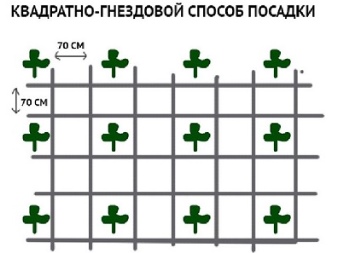
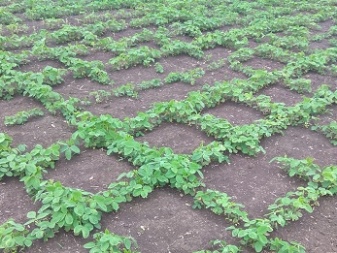
What to consider when landing?
When planting vegetable crops, inexperienced gardeners often make various mistakes that are reflected in fruiting. It is not difficult to avoid them, the main thing is to strictly observe agricultural techniques for each variety and adhere to the advice of experienced specialists. The following recommendations will be useful even for those who have been growing eggplant and other fruit plants for several years. One of the most common mistakes is planting insufficiently strong seedlings. To get the harvest as early as possible, some summer residents transfer the plants before they reach the desired length, and their root systems have developed enough. Under unfavorable weather conditions, some varieties can not only weaken, but also die.
Initially, the seed is germinated in one container. As they grow, a pick is carried out, during which the seedlings are seated in separate containers. Further, hardening is carried out, which is needed for quick and easy adaptation of the eggplant. And only after that - and reaching a certain age - the plants can be transplanted into greenhouses or open ground. The second factor that must be taken into account when planting is the appropriate distance between plants and beds, taking into account all the characteristics: the place of cultivation, the growth of shrubs, the irrigation system, the structure of the plant. To plant the maximum number of seedlings in one area, the planting is often made too thick to get as many vegetables as possible from one square meter. But as a result, the yield drops, and the plants begin to hurt.
The condition of the soil is of great importance for fruiting. If it is depleted, it will not be possible to achieve a rich and high-quality harvest. The situation can be corrected by applying fertilizers. Plants are fed with nutrients during certain phases of growth and development. Acidic soil is deacidified. Digging of the territory is also carried out. Choosing a suitable scheme and properly caring for shrubs, getting a stable harvest every season will not be difficult. Eggplant is a popular vegetable crop. Vegetables are used for preparing salads, hot dishes and preservation for the winter. There is always a place for them both on the festive and on the dinner table every day.
Vegetables can be transported over long distances and stored for a long time without losing taste, smell and attractive appearance.


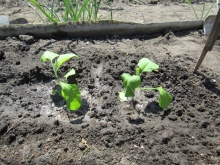












The comment was sent successfully.